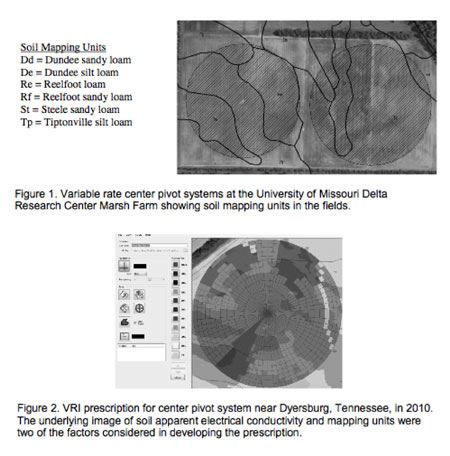Variable Rate Irrigation
PORTAGEVILLE, MO.
Systems are available to producers to make
variable-rate applications of defoliants, fertilizer,
lime, pesticides, plant growth regulators,
and seed. These systems could
potentially offer cost savings to a producer; however,
the full potential of the benefits and savings
cannot be realized if water is not managed
properly. Variable rate irrigation (VRI, also called
site specific or precision irrigation) allows a producer
to apply different rates of water to different
segments of a field. The need for VRI is
similar to the reasons for other variable-rate applications.
Highly variable soils within a field
(clay in lower areas with sandy loam ridges),
topographic variability (high ridges, settling in
filled areas after grading, or drainage ditches in
a field), and multiple crops and/or planting
dates are a few of the situations that would be
helped by VRI. While surface irrigation systems
aren’t well suited for variable rate water application,
center pivot systems can be equipped for
it.
All center pivot systems currently available
from the manufacturers can apply different
rates of water during irrigation by varying speed.
However, most systems cannot change the application
rate along the length of the pivot. The
whole system can speed up to apply less water
or slow down to apply more. However, if a pivot
is simultaneously crossing areas that are wet
(drainage area) and dry (sandy), then a traditional
system would have to address one problem
and over- or under-irrigate the other area.
Conversely, a VRI pivot could apply less water to
the wet area and more to the dry area at the
same time.
The two Valley1 center pivots at the Marsh
Farm are true VRI systems. The east pivot was
converted to variable rate in 2010 and the west
in 2011 for use in the university and ARS irrigation
research programs. Figure 1 shows the
fields and the different soil types. Like most Mid-
South fields, the combination of wind, water,
and seismic activity over the years has resulted
in tremendous soil variability. Areas such as
sand blows and fissures resulting from the New
Madrid earthquakes of 1811-1812 are usually
too small to be included in soil maps, but can
greatly impact irrigation management. Despite
land grading efforts by farmers, these features
still persist in fields and affect the infiltration
and water holding properties of soils. Therefore,
they must be considered in irrigation management
and since they usually make up a small
portion of the total field they can be addressed
quite well with VRI.
Like many variable rate systems, VRI is currently
prescription based. In other words, all
available information is used to develop a map of
the different application amounts needed in the
field; then the information, or prescription, is
uploaded into the VRI controller. Figure 2 shows
a VRI prescription used in 2010 for rice produced
near Dysersburg, Tennessee. The controller
will cause sprinklers in areas receiving
less than 100% of the target application to pulse
on and off to attain the desired amount.
1Mention of trade names or commercial products
is solely for purpose of providing specific information
and does not imply recommendation
or endorsement by the U.S. Department of Agriculture.

In late 2010, researchers from several ARS locations,
including Portageville and Columbia,
decided to coordinate their VRI research efforts.
The resulting Multi-Location Research Project,
“Site-Specific Irrigation Management and Water
Use Efficiency Tools (SSIMWUET)” was created
with the aim of: development of site-specific irrigation
management hardware and software tools
for automation of moving and stationary irrigation
systems as a means to increase crop water
productivity and producer profitability. In addition
to the ARS scientists, many university and
industry colleagues will participate in the research.
While part of the project intends to provide
guidance on preparation of VRI
prescriptions, another goal is the ability to operate
in real-time mode, where the application
can change with each irrigation in response to
sensors measuring soil and/or plant conditions,
allowing the most efficient water use possible. Δ
DR. EARL VORIES: Agricultural
Engineer/USDA-Agricultural Research Service